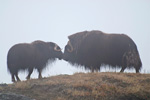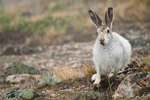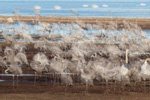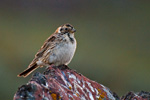Latin name: Ovibos moschatus, Greenlandic: Umimmak
Kangerlussuaq, Greenland
The muskox is an Arctic mammal noted for its thick coat and for the strong odor emitted by males, from which its name derives. This musky odor is used to attract females during mating season.Directly translated, Umimmak, the Greenlandic name for the musk ox, means "the long-bearded one".
The musk ox is the largest land mammal in Greenland.
Latin name: Lepus arcticus, Greenlandic: Ukaleq
Kangerlussuaq, Greenland
The arctic hare is common in most of Greenland. It is about 50cm and 3-4 kg. Summer fur is light grey, winter fur is white. In old times it was caught with string traps, the meat is delicious and the fur was used for clothing.
Latin name: Oryctolagus cuniculus
Scotland
The spread of rabbits throughout Scotland is largely attributed to introductions throughout the Highlands in the 18th and 19th centuries, aided by improved agricultural practices.Rabbits are typically found in short "grass habitats on machairs, dry heaths and agricultural land. They are able to graze these areas closer to the ground than sheep and are well-known catholic feeders which produce the so-called 'disclimax community' of open grassland.
Latin name: Grus grus
Hornborga Lake, Sweden
Every spring, more than 10 000 cranes rest at Lake Hornborga. Most of them spend the winter in Extremadura in southern Spain. They begin in returning to Lake Hornborga in mid-March.The cranes choose Lake Hornborga because of the plentiful access to food.As a feeding point, Bjurum has a history dating back 200 years. What first attracted the cranes was the large potato fields which previously dominated area.
Latin name: Calcarius lapponicus
Narsaq, Greenland
The Lapland Bunting, also known as Lapland Longspur because of their long hind claws, breeds in middle latitude Arctic areas. It is common in Greenland and arrives in march-may and leaves again in august-october.
Latin name: Fulmarus glacialis
Svalbar
The Northern Fulmar have a salt gland that is situated above the nasal passage and helps desalinate their bodies, due to the high amount of ocean water that they imbibe. It excretes a high saline solution from their nose. Breeding Population 500,000–1,000,000 pairs in Svalbard.
© 2011 Eva Johnson/NordArc All rights reserved.





